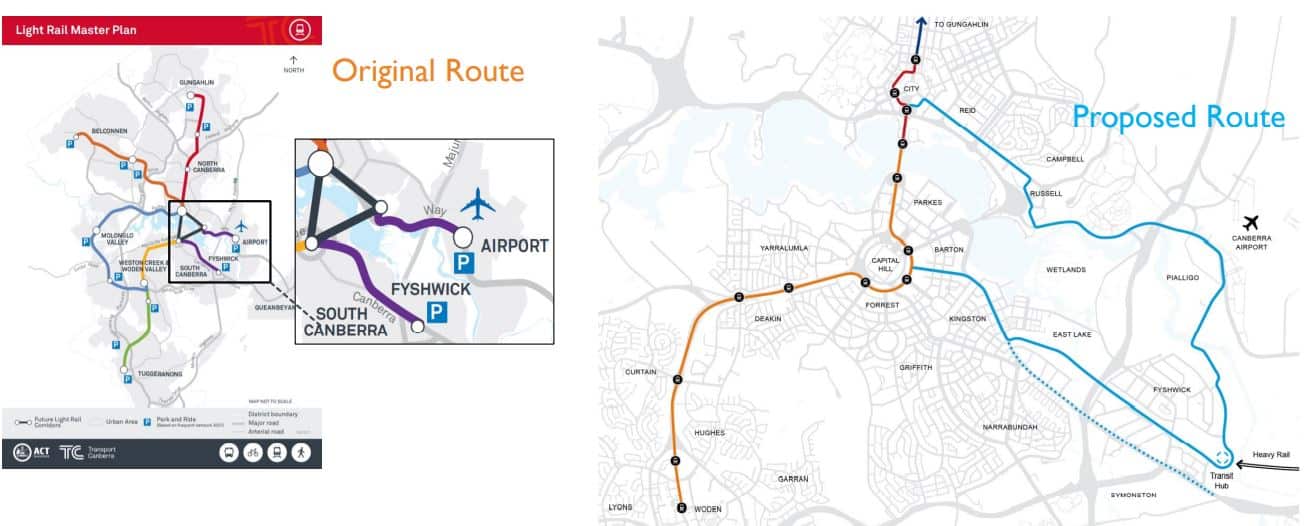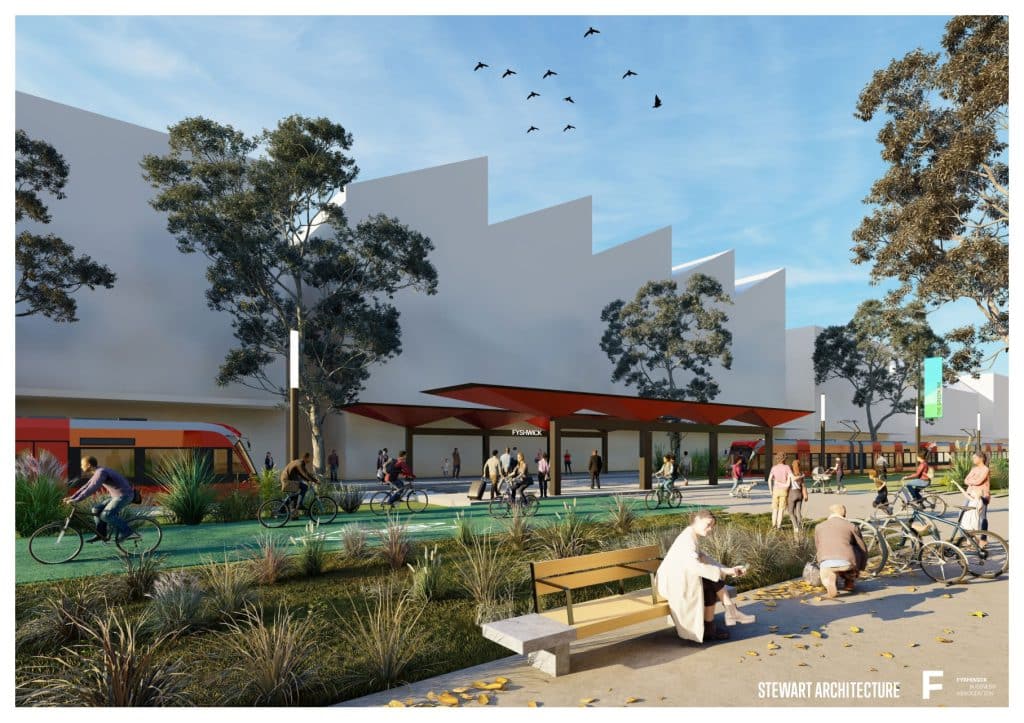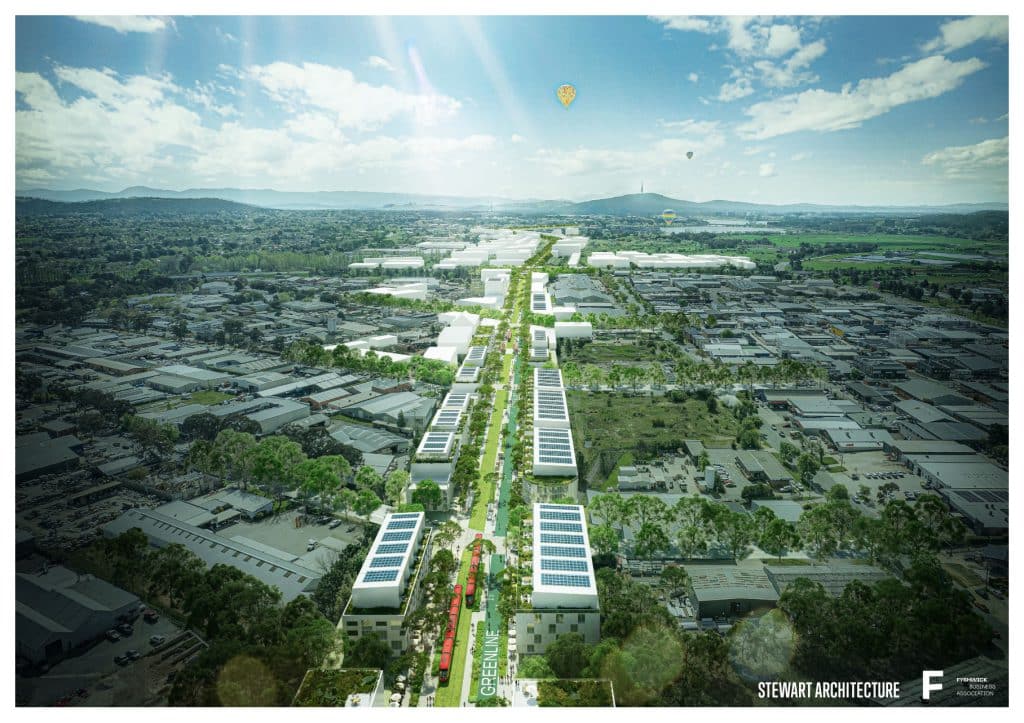Canberra railway station should be moved from Kingston, and the railway line replaced with a new light rail and active travel route serving eastern Canberra, the Fyshwick Business Association argues.
The Association and Stewart Architecture yesterday launched their vision for the Eastwick Greenline, their alternative to the ACT Government’s proposed route – “a vision … [that] will reinvigorate the underutilised rail corridor and build a legacy project that will benefit the whole of the national capital”, Association president Rob Evans said.
In 2015, Transport Canberra stated that eastern connections (Fyshwick and the Airport) were a high priority corridor; its Light Rail Master Plan shows separate routes from the parliamentary triangle to each destination.
The Fyshwick Business Association and Stewart Architecture instead propose realigning the route, as their map shows:

Fyshwick is strategically located in the inner south, between Queanbeyan and Canberra, and close to the East Lake and Kingston Foreshore residential developments, Mr Evans said.
The new light rail corridor would link eastern Canberra and Queanbeyan to Civic and the parliamentary triangle, and serve what he called “a string of pearls”: Manuka Oval, Kingston Foreshore, the Kingston Arts Precinct, Fyshwick Markets, Jerrabomberra Wetlands, East Lake, Dairy Road Precinct, and CIT Fyshwick.
It would, architect Felicity Stewart said, be “an artery across the whole of eastern Canberra”.
Fyshwick is the ACT’s second largest economy (worth $3 billion), and third largest employment precinct (more than 1,500 businesses and 15,500 workers), Mr Evans noted. In addition, 97 per cent of Canberrans visit Fyshwick every year, more than half several times a year, and one in five at least weekly.
However, Fyshwick is not well served by public transport, Mr Evans said. Canberra Avenue is Canberra’s second most congested road (30,000 commuters daily), and one of the two worst for crashes, while Fyshwick is difficult to navigate by bike or scooter. He expected these problems to worsen as population increases over the next decade.
He said the proposed scheme will solve the precinct’s traffic challenges, and drive economic activity and sustainability.
Moving the railway station
Canberra railway station would be moved from Kingston to a new transport hub on the eastern end of Fyshwick, near the current park and ride (on government-owned land).
“The east end of Fyshwick is the perfect place for a brand-new, multi-modal transit hub where heavy rail meets light rail, and which would provide a fitting arrival to the National Capital for people travelling by train instead of the brown box with zero amenity or connectivity that is currently Canberra station,” Mr Evans said. “The hub would also include park-and-ride and end of journey facilities for active travellers.
“People could arrive in Canberra and jump on the light rail or bus to wherever they want to go across the city in a seamless public transport network.”
The current building, constructed in the 1960s, was only intended to be temporary; the government has considered moving the station to the airport / Monaro Highway, with a light rail connection to the city.
The Greenline

The new light rail corridor would be 4 km long and 80 metres wide: 30 metres for the light rail and an active travel path, and 25 metres on either side for development.
The railway corridor is only used part time, mainly by Transport NSW, Ms Stewart said; she described it as “a hostile and barren space”, a no man’s land where kangaroos hop down the line. But, she said, it could be rethought.
She envisages the Greenline as an extensive urban renewal project, transforming Fyshwick from a mono industrial space into an exciting and vibrant place.
It would make Fyshwick a greener neighbourhood, rather than a ‘heat island’ – the hottest place in the ACT, according to CSIRO data – and a new city park would safeguard the Jerrabomberra Wetlands.
“The fundamental challenge of this century is to make our cities more sustainable and healthy places to live,” Ms Stewart said. “This means creating car-free green streets that have outstanding public transport, encourage active travel, and foreground wellbeing for all people. Canberra is uniquely placed to deliver this vision.”
“Canberrans have always ridden bikes, and now e-scooters are popular,” Mr Evans said. “We need to make it easier for people to get out of cars, and we simply cannot squander the opportunity in any new light rail infrastructure to include adjacent safe and accessible active travel corridors.
“Reliable public transport and active travel options are good for business, especially when they take cars off the road in a place which is already clogged with traffic most of the day.”
Pedal Power ACT, the peak cycling body in Canberra, welcomed the plan’s integration of active travel with public transport and good planning.
“This sort of forward thinking is exactly what Canberra needs to create a healthier and more sustainable future”, executive director Simon Copland said.
More room for housing
Moving the station could solve the ACT’s housing crisis, the Eastwick Greenline proponents argue. The new route would free 160,000 square metres of additional developable inner south land that would accommodate up to 9,000 new dwellings, including medium and high-density housing.
This would go a long way to reaching the government’s 70 per cent infill target,” Mr Evans said.
Stewart Architecture principal, Marcus Graham said: “This proposal looks to unlock a significant quantum of underutilised land in central Canberra. Smart infill will help to limit urban development at the fringes of our already sprawling capital city. This project alone could accommodate a significant portion of Canberra’s future growth whilst safeguarding and enhancing key natural assets like the Jerrabomberra Wetlands.”

Economic benefits
The light rail route, Mr Evans said, “would be cheaper and faster to build and … a better value proposition for the government than any other light rail route on the map”.
The land value uplift (the increase in land value from light rail) could go a long way to paying for the infrastructure, Mr Evans said. An independent evaluation showed the land value uplift was at least $570 million.
“That’s a sizeable deposit on an infrastructure project where half the route is already built.”
Using the existing transit corridor, Mr Evans said, would make construction faster, because the corridor is already built, and there were fewer traffic considerations; would save tens of millions of dollars, because the government would not have to dig up Canberra Avenue; and would eliminate the disruption to arterial traffic and productivity loss caused by construction along Canberra Avenue.
Political responses
Mr Evans expects the scale and importance of the infrastructure and its links to the airport and the wider capital region should attract both federal and NSW funding.
Senator David Pocock said he supported the “really exciting” proposal, and hoped the federal government would back a proper study into it.
“It ticks a lot of boxes in terms of infill, green space, active transport,” Senator Pocock said.
Moreover, Mr Evans argued, the proposal met all of the 10 targets in the ACT Government’s draft District Strategy: Inner South. That paper, he noted, already recognises the Eastwick Greenline route as a “strategic investigation corridor”, “supporting future rapid transport links and a stronger network of connections to and between activity nodes”.
Mr Evans said that feedback from ACT Ministers, MLAs, planning and transport officials, industry and community groups, and Fyshwick Business Association members has been positive.
The ACT Government welcomed the enthusiasm for the Fyshwick Business Association’s light rail project. “It speaks to the success of the project and the willingness of Canberrans to support the extension of the light rail network beyond stage 1.”
However, light rail to Fyshwick is some way down the government’s list of priorities.
The government’s current focus is to deliver stage 2 of light rail to Woden, starting with the first leg of the extension from Alinga Street to Commonwealth Park, the spokesperson said. The next stage for consideration would be out to Belconnen, followed by Tuggeranong. The government will then consider other linkages between Fyshwick/Queanbeyan and the Molonglo Valley.
The ACT Government is refreshing the light rail network plan to reflect current thinking on the future light rail network for Canberra, the spokesperson said. This work will inform future transport and land use planning for future stages of light rail, particularly the future east-west stage 3 route to Belconnen. The Queanbeyan Region Integrated Transport Plan, released by Transport for NSW, will also be taken into consideration.
“It is heartening to see Canberra businesses get on board with the light rail project, as construction ramps up on the second stage.”
Damien Haas, chair of the Public Transport Association of Canberra, considered it an excellent proposal that would revitalise both Fyshwick and the inner south. In his opinion, it should not be prioritised before light rail to Belconnen, but the loop to the airport could be built at the same time.
The public can comment online via www.fyshwickbusiness.com.au. The Fyshwick Business Association will summarise and pass on those comments to the government.
Get local, national and world news, plus sport, entertainment, lifestyle, competitions and more delivered straight to your inbox with the Canberra Daily Daily Newsletter. Sign up here.



